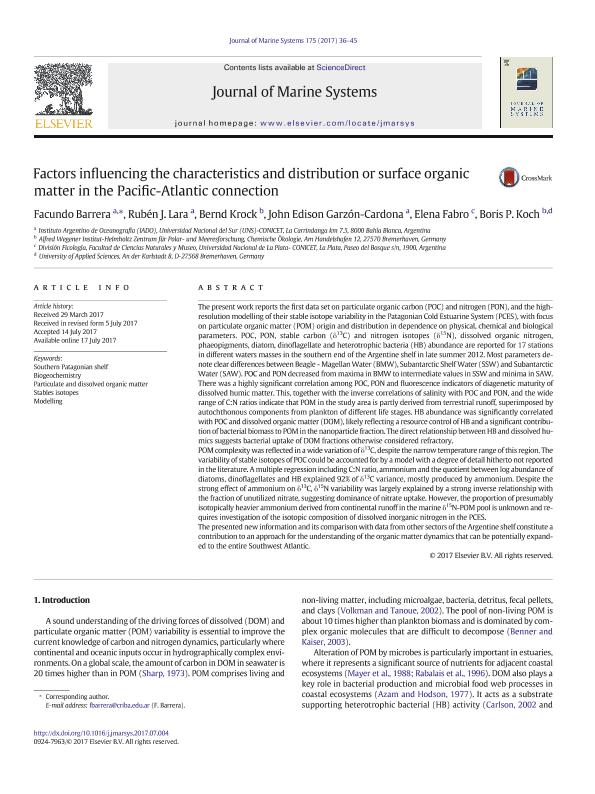Mostrar el registro sencillo del ítem
dc.contributor.author
Barrera, Facundo Matías

dc.contributor.author
Lara, Ruben Jose

dc.contributor.author
Krock, Bernd
dc.contributor.author
Garzon Cardona, John Edison

dc.contributor.author
Fabro Cerreia Fus, Elena Ines

dc.contributor.author
Koch, Boris Peter

dc.date.available
2018-12-03T18:43:21Z
dc.date.issued
2017-11
dc.identifier.citation
Barrera, Facundo Matías; Lara, Ruben Jose; Krock, Bernd; Garzon Cardona, John Edison; Fabro Cerreia Fus, Elena Ines; et al.; Factors influencing the characteristics and distribution or surface organic matter in the Pacific-Atlantic connection; Elsevier Science; Journal Of Marine Systems; 175; 11-2017; 36-45
dc.identifier.issn
0924-7963
dc.identifier.uri
http://hdl.handle.net/11336/65635
dc.description.abstract
The present work reports the first data set on particulate organic carbon (POC) and nitrogen (PON), and the high-resolution modelling of their stable isotope variability in the Patagonian Cold Estuarine System (PCES), with focus on particulate organic matter (POM) origin and distribution in dependence on physical, chemical and biological parameters. POC, PON, stable carbon (δ13C) and nitrogen isotopes (δ15N), dissolved organic nitrogen, phaeopigments, diatom, dinoflagellate and heterotrophic bacteria (HB) abundance are reported for 17 stations in different waters masses in the southern end of the Argentine shelf in late summer 2012. Most parameters denote clear differences between Beagle - Magellan Water (BMW), Subantarctic Shelf Water (SSW) and Subantarctic Water (SAW). POC and PON decreased from maxima in BMW to intermediate values in SSW and minima in SAW. There was a highly significant correlation among POC, PON and fluorescence indicators of diagenetic maturity of dissolved humic matter. This, together with the inverse correlations of salinity with POC and PON, and the wide range of C:N ratios indicate that POM in the study area is partly derived from terrestrial runoff, superimposed by autochthonous components from plankton of different life stages. HB abundance was significantly correlated with POC and dissolved organic matter (DOM), likely reflecting a resource control of HB and a significant contribution of bacterial biomass to POM in the nanoparticle fraction. The direct relationship between HB and dissolved humics suggests bacterial uptake of DOM fractions otherwise considered refractory. POM complexity was reflected in a wide variation of δ13C, despite the narrow temperature range of this region. The variability of stable isotopes of POC could be accounted for by a model with a degree of detail hitherto not reported in the literature. A multiple regression including C:N ratio, ammonium and the quotient between log abundance of diatoms, dinoflagellates and HB explained 92% of δ13C variance, mostly produced by ammonium. Despite the strong effect of ammonium on δ13C, δ15N variability was largely explained by a strong inverse relationship with the fraction of unutilized nitrate, suggesting dominance of nitrate uptake. However, the proportion of presumably isotopically heavier ammonium derived from continental runoff in the marine δ15N-POM pool is unknown and requires investigation of the isotopic composition of dissolved inorganic nitrogen in the PCES. The presented new information and its comparison with data from other sectors of the Argentine shelf constitute a contribution to an approach for the understanding of the organic matter dynamics that can be potentially expanded to the entire Southwest Atlantic.
dc.format
application/pdf
dc.language.iso
eng
dc.publisher
Elsevier Science

dc.rights
info:eu-repo/semantics/openAccess
dc.rights.uri
https://creativecommons.org/licenses/by-nc-sa/2.5/ar/
dc.subject
Biogeochemistry
dc.subject
Modelling
dc.subject
Particulate And Dissolved Organic Matter
dc.subject
Southern Patagonian Shelf
dc.subject
Stables Isotopes
dc.subject.classification
Meteorología y Ciencias Atmosféricas

dc.subject.classification
Ciencias de la Tierra y relacionadas con el Medio Ambiente

dc.subject.classification
CIENCIAS NATURALES Y EXACTAS

dc.title
Factors influencing the characteristics and distribution or surface organic matter in the Pacific-Atlantic connection
dc.type
info:eu-repo/semantics/article
dc.type
info:ar-repo/semantics/artículo
dc.type
info:eu-repo/semantics/publishedVersion
dc.date.updated
2018-10-22T18:05:25Z
dc.journal.volume
175
dc.journal.pagination
36-45
dc.journal.pais
Países Bajos

dc.journal.ciudad
Amsterdam
dc.description.fil
Fil: Barrera, Facundo Matías. Consejo Nacional de Investigaciones Científicas y Técnicas. Centro Científico Tecnológico Conicet - Bahía Blanca. Instituto Argentino de Oceanografía. Universidad Nacional del Sur. Instituto Argentino de Oceanografía; Argentina
dc.description.fil
Fil: Lara, Ruben Jose. Consejo Nacional de Investigaciones Científicas y Técnicas. Centro Científico Tecnológico Conicet - Bahía Blanca. Instituto Argentino de Oceanografía. Universidad Nacional del Sur. Instituto Argentino de Oceanografía; Argentina
dc.description.fil
Fil: Krock, Bernd. Alfred Wegener Institut; Alemania
dc.description.fil
Fil: Garzon Cardona, John Edison. Consejo Nacional de Investigaciones Científicas y Técnicas. Centro Científico Tecnológico Conicet - Bahía Blanca. Instituto Argentino de Oceanografía. Universidad Nacional del Sur. Instituto Argentino de Oceanografía; Argentina
dc.description.fil
Fil: Fabro Cerreia Fus, Elena Ines. Consejo Nacional de Investigaciones Científicas y Técnicas. Centro Científico Tecnológico Conicet - La Plata; Argentina. Universidad Nacional de La Plata. Facultad de Ciencias Naturales y Museo. División Ficología; Argentina
dc.description.fil
Fil: Koch, Boris Peter. Alfred Wegener Institut; Alemania. University of Applied Sciences; Alemania
dc.journal.title
Journal Of Marine Systems

dc.relation.alternativeid
info:eu-repo/semantics/altIdentifier/url/http://www.sciencedirect.com/science/article/pii/S0924796317301331
dc.relation.alternativeid
info:eu-repo/semantics/altIdentifier/doi/https://dx.doi.org/10.1016/j.jmarsys.2017.07.004
Archivos asociados
